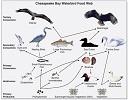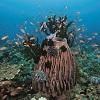Community and ecosystem ecology provides a method for examining the relationships between organisms, in both aquatic and terrestrial environments, at medium levels of organization. The most basic levels of organization are the species and population levels. Conversely, the largest levels of organization are the biome and biosphere levels. The following schematic presents this classification system for the different levels of organization in ecology.
Levels of Organization (smallest to largest)
1. Species -- 2. Population -- 3. Community -- 4. Ecosystem -- 5. Biome -- 6. Bisphere
A community can be defined as all the individuals of different species living together in a particular geographic area. An ecosystem is one level larger than a community because it considers not only a community of biological organisms, but also their environment. At these levels of organization, different ecological mechanisms and processes can be analyzed.
For example, at the ecosystem level, processes such as energy transfer between organisms can be interpreted in attempts to understand the inputs and outputs of energy in an ecosystem. The initial output of energy would be from the atmosphere in the form of CO2 and the first intake of this energy would be from plants. This energy would then be continually transferred between different organisms. For instance, energy would travel from plants to animals and then back to the atmosphere and also from plants to the soil to the decomposers and back to the atmosphere.
In an ecosystem the environment, more specifically the climate, largely controls the functioning and stability of the total system. When dealing with climate, the variables being considered are air temperature and precipitation. At the community level, the focus is placed more heavily upon examining all the species within a community and their interaction with each other. For example, interactions such as herbivory and mutualism may be analyzed.
Community and ecosystem ecology provides a framework for analyzing the different ecological mechanisms and principles underlying a system. Understanding the functions of both these systems and the factors controlling them is critical to the study of ecology.
References:
Image Credit: U.S Geological Survey. (2009). Unearthing Secrets of the Forest. Retrieved from http://pubs.usgs.gov/fs/2009/3078/
© BrainMass Inc. brainmass.com June 30, 2024, 6:30 am ad1c9bdddf




